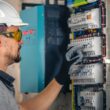In this article, we will delve into the chemical reaction between copper (Cu) and nitric acid (HNO3). This reaction leads to the formation of copper nitrate (Cu(NO3)2), nitrogen dioxide (NO2), and water (H2O). We will explore the reaction mechanism, the balanced chemical equation, and the various factors influencing the reaction’s outcome.
Reaction mechanism
The reaction between copper and nitric acid is an example of a redox reaction, where electrons are transferred between reactants. Nitric acid is a powerful oxidizing agent that readily donates oxygen to other substances. In the case of copper, the reaction proceeds as follows:
Cu + 4HNO3 → Cu(NO3)2 + 2NO2 + 2H2O
When copper reacts with nitric acid, the copper atoms lose electrons, while nitric acid molecules are reduced by gaining electrons. This results in the formation of copper ions (Cu^2+) and nitrogen dioxide gas, along with water and copper nitrate.
Factors affecting the reaction
Several factors influence the rate and efficiency of the Cu + HNO3 reaction:
- Concentration of Nitric Acid: A higher concentration of nitric acid leads to a faster reaction rate, as more nitric acid molecules are available to participate in the reaction.
- Surface Area of Copper: Finely divided or powdered copper has a larger surface area, which facilitates the reaction by providing more contact points for nitric acid molecules.
- Temperature: Increasing the temperature generally accelerates chemical reactions by providing more energy to the reacting molecules.
- Catalysts: Certain catalysts can promote the reaction between copper and nitric acid, reducing the activation energy required for the reaction to occur.
Precautions
Handling nitric acid requires caution, as it is a strong oxidizing agent and can be corrosive. When conducting this reaction, it’s essential to wear appropriate protective gear, work in a well-ventilated area, and follow proper laboratory safety protocols.
Frequently Asked Questions (FAQs)
Q: What is the product of the reaction between copper and nitric acid?
A: The products of the reaction are copper nitrate (Cu(NO3)2), nitrogen dioxide (NO2), and water (H2O).
Q: Why does the reaction between copper and nitric acid produce brown fumes?
A: The brown fumes observed during the reaction are due to the presence of nitrogen dioxide (NO2) gas, which is a reddish-brown gas.
Q: Can I use concentrated nitric acid for this reaction?
A: Yes, concentrated nitric acid can be used for the reaction, but it should be handled with care due to its corrosive and oxidizing properties.
Q: What is the significance of the copper nitrate formed in the reaction?
A: Copper nitrate has various applications, including as a component in certain chemical processes and as a reagent in laboratory experiments.
Conclusion
The reaction between copper and nitric acid is a notable example of a redox reaction, resulting in the formation of copper nitrate, nitrogen dioxide, and water. Understanding the reaction mechanism and the factors influencing the reaction’s rate is crucial for both scientific curiosity and practical applications.




